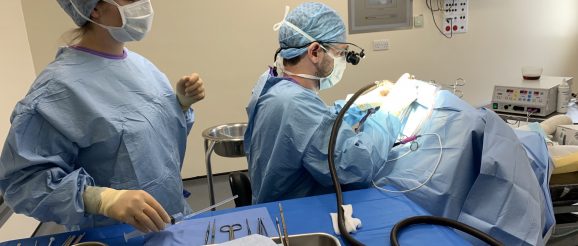Hypophysectomy at the RVC – A decade of innovation to help cats and dogs

Hypophysectomy is a surgical procedure performed to remove the pituitary gland and any associated tumour that may be impairing patient quality of life. The Royal Veterinary College (RVC) pioneered the technique in UK veterinary practice a decade ago and has continued to lead and progress the field.
The pituitary gland, also known as the hypophysis, is found at the base of mammalian brains. It has a variety of important functions, controlling the hormones produced by various glands, including the adrenal and thyroid glands. However, occasionally a tumour can form within the pituitary leading to overproduction of certain hormones and resulting in clinical signs, as well as in some cases growing big enough to exert pressure on the surrounding brain. As a result, surgical removal often gives the best prognosis for the patient by offering the possibility of both curing the hormonal disease and removing the growing mass.
Transsphenoidal hypophysectomy means that surgery is performed through a hole in the sphenoid bones at the base of the skull. This involves accessing the skull base through the soft palate in the back of the mouth then using a high-speed surgical drill to reach the pituitary. Access to this area of the brain is technically difficult and the team at the RVC is helped by cutting-edge diagnostic imaging and surgical equipment, such as the Brainsight neuro-navigation system head frame.
This approach was pioneered at the RVC by Neurology and Neurosurgery specialist, Patrick Kenny. The UK’s first successful feline hypophysectomy surgery was performed here in April 2012, to treat a cat with acromegaly and diabetes mellitus. Over the six years since Patrick left the RVC, we have developed a great deal of experience with the technique and have seen a range of challenging cases.
Hypophysectomy is most frequently performed at the RVC in dogs and cats suffering from acromegaly and pituitary-dependent Cushing’s syndrome, caused by hormone-producing pituitary tumours. Since pioneering the procedure in the UK, the RVC team has treated 120 cats and 25 dogs with pituitary tumours, providing treatment for pets and owners for which there have traditionally been limited options.
Acromegaly and diabetes mellitus in cats
Acromegaly is a rare condition where the body produces too much growth hormone, causing rapid and excessive growth. It can lead to diabetes mellitus. Although it is technically challenging, surgical hypophysectomy is now considered the optimal treatment option for feline acromegaly. Over the past 10 years of performing the procedure, the RVC team has placed great emphasis on using their experience to maximise patient safety and outcome.
In cats with acromegaly and diabetes mellitus, hypophysectomy is associated with a 70% rate of surviving cats achieving complete diabetic remission, with significant improvements in insulin responsiveness seen in the vast majority of the other 30% of patients. Cats typically stay at our Queen Mother Hospital for Animals for a week to 10 days post-operatively while the team stabilises their diabetes.
Hypophysectomy only involves one general anaesthetic procedure, providing an advantage over radiation therapy. Medical management of cats with acromegaly and diabetes mellitus is typically cost prohibitive and can be extremely challenging for owners to maintain effectively. The team at the RVC has also recently successfully performed hypophysectomy for the first time to treat a rare case of a dog with acromegaly, marking another landmark in the use of this procedure in pets.
Pituitary-dependent Cushing’s syndrome
Hypophysectomy is also an excellent treatment option for pituitary-dependent Cushing’s syndrome, most often seen in dogs with pituitary tumours. Dogs typically recover very quickly post-operatively and are often discharged within five days. Resolution of the clinical signs of Cushing’s is typically dramatic and dogs demonstrate an excellent quality of life post-operatively. Although less frequently encountered, the team has also treated a handful of cats with pituitary-dependent Cushing’s syndrome.
Although other options are available for treatment of pituitary-dependent Cushing’s syndrome, including life-long trilostane therapy and radiotherapy, hypophysectomy confers advantages over these options, including the removal of the growing tumour and potential for complete cessation of hormone production. Although radiation therapy results in a reduction of tumour size and associated neurological signs, improvements in hormone production remain very variable.
The work to help pets with such complex and debilitating conditions requires collaboration between skilled neurosurgeons, critical care, internal medicine and anaesthesia specialists at RVC Small Animal Referrals. This sort of transdisciplinary collaboration and communication is something we take pride in at the RVC as it enables us to work together for the benefit of each animal that needs our help. This collaboration between different teams is also extremely good for veterinary education, including postgraduate specialist training.
Joe Fenn, Senior Lecturer in Veterinary Neurology and Neurosurgery at the Royal Veterinary College
